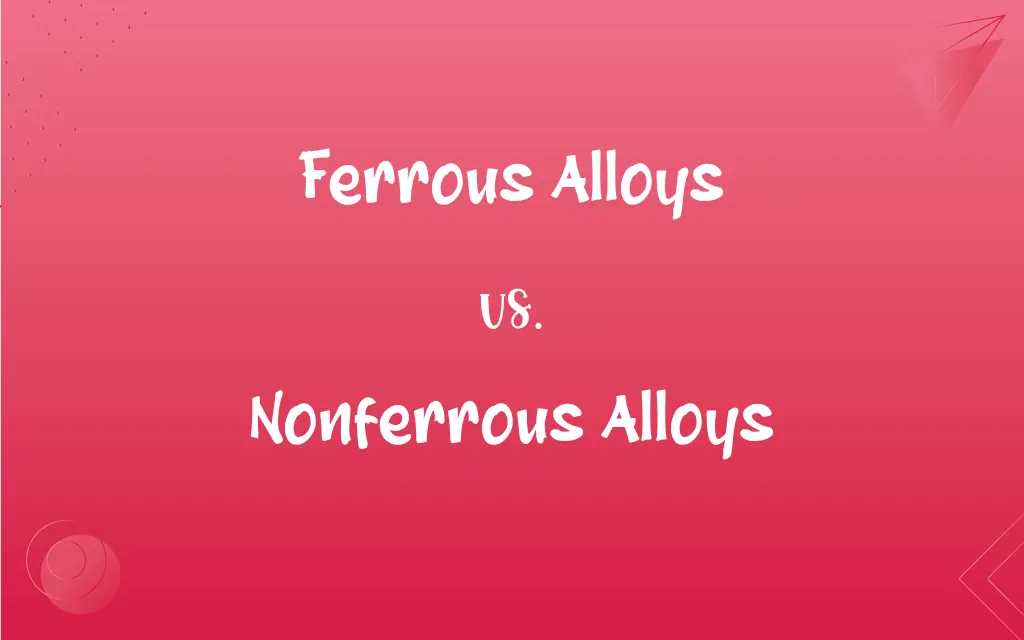Ferrous Alloys vs. Nonferrous Alloys: What's the Difference?
Edited by Aimie Carlson || By Janet White || Published on February 8, 2024
Ferrous alloys contain iron while nonferrous alloys do not contain iron.

Key Differences
Ferrous Alloys are primarily composed of iron and often contain carbon and other elements. They are known for their strength and durability. Nonferrous Alloys, on the other hand, do not contain iron. These alloys, such as those made from copper, aluminum, or zinc, are typically more resistant to corrosion and are lighter in weight.
Ferrous Alloys are magnetic, a property stemming from their iron content. This characteristic makes them ideal for motors and electrical applications. In contrast, Nonferrous Alloys are generally non-magnetic, making them suitable for electronic and wiring applications where magnetic interference needs to be minimized.
Ferrous Alloys often have a higher tensile strength, making them ideal for construction and heavy machinery. Nonferrous Alloys, with lower strength, are more malleable and find uses in applications like aircraft manufacturing due to their lighter weight.
Ferrous Alloys are usually more affordable due to the abundance of iron. They are commonly used in buildings, tools, and automobiles. Nonferrous Alloys, however, tend to be more expensive, used in more specialized applications such as electrical components, due to their specific properties like corrosion resistance.
Ferrous Alloys are prone to rust when exposed to moisture, a limitation in certain environments. Nonferrous Alloys are more resistant to rust and corrosion, making them ideal for use in marine applications and environments with high moisture.
ADVERTISEMENT
Comparison Chart
Composition
Contain iron
Do not contain iron
Magnetic Properties
Generally magnetic
Typically non-magnetic
Strength and Weight
Higher strength, heavier
Lower strength, lighter
Cost
Usually more affordable
Generally more expensive
Corrosion Resistance
Prone to rust
More resistant to corrosion
ADVERTISEMENT
Ferrous Alloys and Nonferrous Alloys Definitions
Ferrous Alloys
Ferrous alloys are predominantly iron, making them heavier and more magnetic than nonferrous alloys.
Cast iron, a ferrous alloy, is commonly used in heavy machinery due to its weight and strength.
Nonferrous Alloys
Nonferrous alloys are metals that do not contain iron, offering corrosion resistance.
Brass, a nonferrous alloy, is often used in plumbing fixtures for its resistance to corrosion.
Ferrous Alloys
Ferrous alloys are characterized by their susceptibility to rust when exposed to moisture.
Mild steel, a ferrous alloy, requires coating to prevent rust in outdoor applications.
Nonferrous Alloys
Nonferrous alloys are known for their lightweight and non-magnetic properties.
Aluminum alloys, nonferrous in nature, are used in aircraft manufacturing due to their light weight.
Ferrous Alloys
Ferrous alloys are iron-based metals mixed with various elements for enhanced properties.
Stainless steel, a ferrous alloy, is used in kitchen appliances for its corrosion resistance.
Nonferrous Alloys
Nonferrous alloys include metals like copper, aluminum, and zinc, each offering unique characteristics.
Copper alloys, being nonferrous, are ideal for electrical wiring due to their excellent conductivity.
Ferrous Alloys
Ferrous alloys often contain carbon and are known for their strength and magnetic properties.
Carbon steel, a type of ferrous alloy, is widely used in construction due to its high strength.
Nonferrous Alloys
Nonferrous alloys are typically used in specialized applications where weight and corrosion resistance are crucial.
Titanium alloys, nonferrous and strong, are favored in aerospace engineering.
Ferrous Alloys
Ferrous alloys are primarily used for their durability and tensile strength.
Wrought iron, a ferrous alloy, is often chosen for outdoor furniture because of its durability.
Nonferrous Alloys
Nonferrous alloys are often more expensive than ferrous alloys but provide specific benefits like malleability.
Bronze, a nonferrous alloy, is used in sculpture for its workability and aesthetic appeal.
FAQs
Are all ferrous alloys magnetic?
Most ferrous alloys are magnetic due to their iron content.
Why are nonferrous alloys important in industry?
Nonferrous alloys are crucial for applications requiring corrosion resistance and lighter weight.
Can ferrous alloys resist corrosion?
Some ferrous alloys, like stainless steel, are treated to resist corrosion.
Why are nonferrous alloys non-magnetic?
The absence of iron makes nonferrous alloys generally non-magnetic.
Are nonferrous alloys heavier than ferrous alloys?
Nonferrous alloys are typically lighter than ferrous alloys.
Is rust a concern for nonferrous alloys?
Nonferrous alloys are generally more resistant to rust and corrosion.
What makes nonferrous alloys expensive?
The scarcity of base metals and specialized properties make nonferrous alloys expensive.
Do ferrous alloys have a high melting point?
Ferrous alloys typically have a higher melting point than nonferrous alloys.
Do ferrous alloys have a higher strength than nonferrous?
Ferrous alloys often have higher tensile strength compared to nonferrous alloys.
What is the environmental impact of nonferrous alloys?
Nonferrous alloys often require more energy to produce but are highly recyclable.
What defines a ferrous alloy?
Ferrous alloys contain iron as their primary component.
Are nonferrous alloys suitable for aerospace use?
Yes, their light weight and strength make them ideal for aerospace.
Can ferrous alloys be used in electrical applications?
Ferrous alloys' magnetic properties limit their use in certain electrical applications.
How does the weight of ferrous alloys impact their use?
The weight of ferrous alloys makes them suitable for sturdy, load-bearing structures.
What are the common uses of ferrous alloys?
Ferrous alloys are used in construction, automotive, and tool manufacturing.
Are nonferrous alloys easy to machine?
Yes, nonferrous alloys are often more malleable and easier to machine.
Can nonferrous alloys be recycled?
Nonferrous alloys are highly recyclable, often without loss of properties.
What is the role of carbon in ferrous alloys?
Carbon is added to ferrous alloys to increase hardness and strength.
Do ferrous alloys conduct electricity well?
Ferrous alloys are not as good conductors of electricity as nonferrous alloys.
What is the impact of corrosion on ferrous alloys?
Corrosion can significantly weaken ferrous alloys if not properly treated.
About Author
Written by
Janet WhiteJanet White has been an esteemed writer and blogger for Difference Wiki. Holding a Master's degree in Science and Medical Journalism from the prestigious Boston University, she has consistently demonstrated her expertise and passion for her field. When she's not immersed in her work, Janet relishes her time exercising, delving into a good book, and cherishing moments with friends and family.
Edited by
Aimie CarlsonAimie Carlson, holding a master's degree in English literature, is a fervent English language enthusiast. She lends her writing talents to Difference Wiki, a prominent website that specializes in comparisons, offering readers insightful analyses that both captivate and inform.






































































